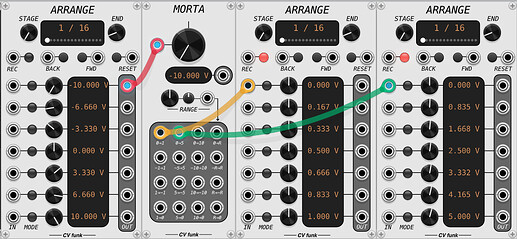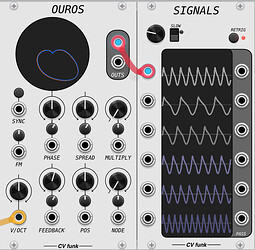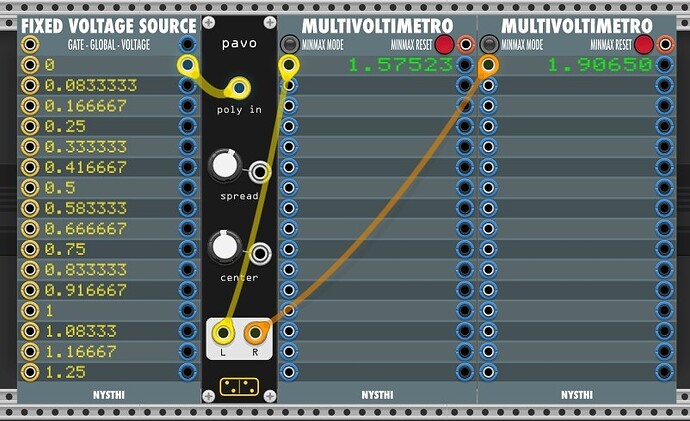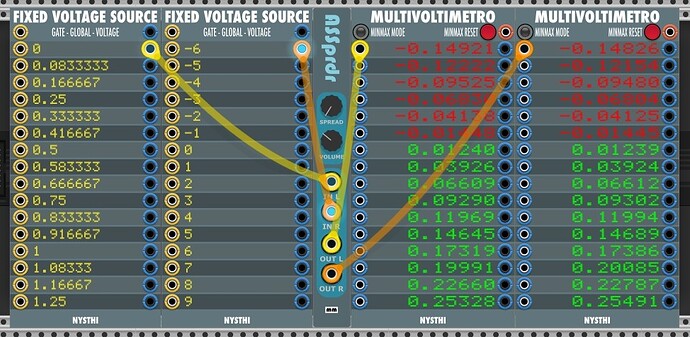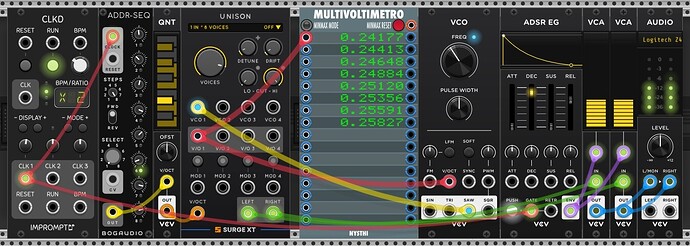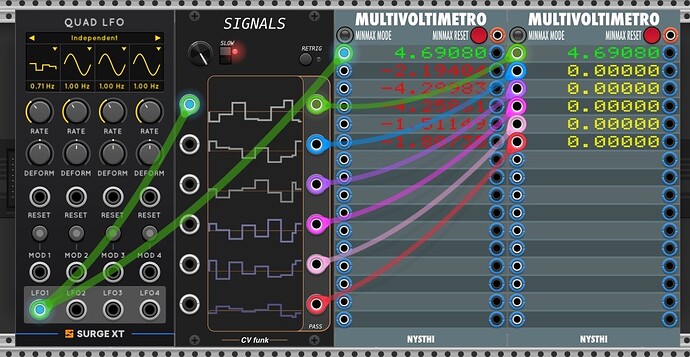It’s pretty clear that there are some modules that are what I call “massively polyphonic”. And then a lot that are not. Quite interesting.
can be also Splitter and Merger (+ adder of channels)
Thanks Alpha, great list. To add: SurgeXT::UnisonHelper
CVfunk::Morta now handles poly inputs. It rescales all the inputs to different fixed ranges (and one variable range).
Here showing some -10…10V signals mapped to 0…1V and 0…5V.
Also, CVfunk::Signals can now distribute a poly input to its 6 channels:
I would not be opposed to including polyphonic stereo spreaders. I actually tested the ones you mention with CV values and don’t quite know what to make of the results. It’s probably just me ![]() .
.
Both, Spread and Pavo seem to convert the polyphonic stereo input to a monophonic stereo output.
ASSprdr maintains the polyphony (if ‘Merge Poly Output’ is deselected in the context menu), but the output values are very different from the input values.
Any help or explanation would be much appreciated here. Aside from spreading audio signals (I suppose through yielding different voltages on left and right stereo channel?), can this be put to any good use for manipulating polyphonic CV?
Really cool initiative. This make me think that a personalized taxonomy / sub-categorization system could be really nice in the VCV library. It could spare me long minutes of head-scratching searching what module fits with a specific need.
Thank you for pointing this out! I’d still keep MultiVoltimetro among the ‘Polyphonic meters/visualizers’ though, because is simply invaluable as a meter.
There is nothing wrong with listing the same module multiple times if it performs multiple functions - a bit more work perhaps, but useful
Yes, great! Is this a way UnisonHelper could be wired for stereo unison?
Yes, your are right that it would definitely be useful, so someone just needs to look at the (sub-)category and will find modules that can be applied.
Considering the long (and hopefully growing) list, I just fear to lose track, but maybe with some classification help from the community it might be manageable. Suggestions always welcome.
I would welcome some kind of extended/improved classification/taxonomy in VCV Rack. This in part prompted me to start this list, too.
I often have a specific task or need in mind and then go on a somewhat laborious hunt for the proper module. IMO, having a more granular structure to the library would significantly ease this process.
Is e.g. assigning custom tags anywhere on the horizon?
If you would like help editing the original post, then I think you can make it a Wiki post.
At the bottom of your post, click on the three dots (show more) next to the Reply. Then click on the wrench (post admin actions), and select Make Wiki. I haven’t done this before on this site, but I believe it allows others to edit your post. I know that is how it works on StackOverflow.
Let’s give this a try! I converted the OP to a Wiki post.
In order to keep this list useful to all and prevent chaos, I would like to encourage everyone who contributes to stick to the format when adding content and contact me to discuss improvements.
Thank you and happy adding!
Has this already been implemented? I can see the curves in Signals, but don’t get any voltage on the outputs, except for the first channel. Is there another setting?
Updated with a few additional modules. Wiki post (Thank you, Dave!). Started to link names to posts with patch selections.
Oooh. Okay I need to fix that. It should pass all the poly voltages out! Oops. It will be in v2.0.9 Thanks for the bug report!!
edit: fixed for the new release
Ohh, no worries, thank you for fixing it so quickly! I was not aware of Signals before — I like it!
@Alphagem-O the spreader modules are for audio, not CV, maybe that was my misunderstanding. If you have more than one voice on a poly cable from an audio out, it gives you a stereo pair of outputs where each voice is spread across the stereo field. CV and audio are basically interchangeable, right?
Hope that makes sense! ![]()
Thank you for explaining and confirming my notion!
Yes, in the end, even audio somehow has to be transported through a voltage. At least ASSprdr has the option to turn ‘Merge Poly Output’ off, so the developer may have had something in mind for poly-CV as well.
But audio clearly seems to be the main objective for these spreaders and they still are very important elements in the toolbox.
